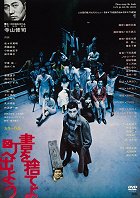Directed by:
Shûji TerayamaComposer:
J.A. SeazerCast:
Hideaki Sasaki, Sei Hiraizumi, 美輪明宏, J.A. Seazer, Keiko Niitaka, Yukiko Kobayashi, Sakumi HagiwaraReviews (1)
Maestro Terayama clearly did not fear very sharp irony, bordering on mockery within his own ranks - already in his feature film debut about the ketchup emperor, it was strange to see a legend of avant-garde Japanese theater ridicule the youth counterculture of the late 1960s (thus one of the important conditions of the underground/independent/experimental scene of that time, in which Terayama himself was involved) - but here the irony is balanced with tolerance towards youth as such and in places even genuine appreciation of its radicalism. The overall (intentionally) humorous scenes of the coming-of-age of the main non-hero provide the backdrop (somewhat condescendingly - Terayama was 35 years old, so almost a generation removed from the main characters of the film) for the double exploration of a generation and its world. The surreal image of a burning airplane with a red flag in the background, which burns along with it, can serve as an explanation of the author's entire perspective on the student movement: the inexperienced youth (symbolized in the film by the airplane) turns to ashes as part of the protagonist's maturation, and likewise, the red flag (which in the film uniquely symbolizes a red flag) ends in flames - the left-wing radicalism of the youth at the time serves as a mediator in their transition to a more mature phase of independent creation and life. /// Otherwise, it is truly a product of a unique period in cinema - metafiction, the insertion of separate sequences capturing artistic performances in the streets of Tokyo, surrealistic scenes, playing with filters, etc. One slightly disappointing aspect was the unexpectedly simple portrayal of the central plot. However, for some (more so the majority of viewers) this will be seen as a positive aspect, as it doesn't get lost in the complexity of the form.
()
